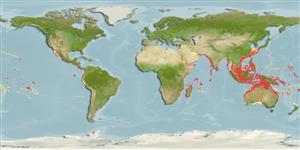Environment: milieu / climate zone / depth range / distribution range
Ecologia
marinhas; Água doce; estuarina associadas(os) a recifes; anfídromo; intervalo de profundidade 0 - 146 m (Ref. 57178). Tropical; 26°C - 29°C; 32°N - 36°S, 25°E - 77°W
Indo-Pacific: Red Sea and East Africa to Hawaii, north to southern Japan and the Ogasawara Islands, south to Australia and New Caledonia. Eastern Pacific: southwestern coast of Baja California Sur, Mexico and the Gulf of California to Ecuador and the Galapagos Islands (Ref. 9283).
Length at first maturity / Tamanho / Peso / Idade
Maturity: Lm 42.0 range ? - ? cm
Max length : 120 cm TL macho/indeterminado; (Ref. 9987); common length : 60.0 cm FL macho/indeterminado; (Ref. 3287); peso máx. Publicado: 18.0 kg (Ref. 9987)
Espinhos dorsais (total): 9; Raios dorsais moles (total): 19-22; Espinhos anais 3; Raios anais moles: 14 - 17; Vértebras: 25. This species is distinguished by the following characters: dorsal profile moderately convex anteriorly; adipose eyelid well developed, moderate anteriorly, posterior eyelid extends onto eye to rear border of pupil; gill rakers (including rudiments) 6-8 + 15-19 = 21-25; straight part of lateral line with 0-3 anterior scales followed by 27-36 strong, dark scutes; breast completely scaly; vertebrae 10+15; upper jaw with outer row of strong canines widely spaced in adults, and an inner band of small villiform teeth, widest at symphysis; on lower limb of first gill arch jaw with a single row of strong conical teeth widely spaced in adults. Colour in life with adults' head and body silvery olive to iridescent blue-green above, silvery olive to whitish below; small blackish spot, much smaller than pupil diameter, at upper angle of opercle (this spot evident on specimens of about 14 cm fork length); second dorsal fin olive to blackish, the lobe with a white tip (white tip becomes more obvious with increasing size) (Ref. 9894).
Adults inhabit coastal and oceanic waters associated with reefs (Ref. 9283, 58302). Pelagic at 1-96 m (Ref. 58302). They are often seen in large daytime schools but solitary at night when feeding (Ref. 90102). During the day they are usually seen milling in stationary aggregations (Ref. 44894), forming slow-moving schools in the passes or outside the reef (Ref. 4795). Juveniles may be encountered in estuaries (Ref. 9283, 44894), occasionally entering rivers and penetrating well inland (Ref. 2847, 44894). Adults feed mainly on fishes, squids and crustaceans (Ref. 9283, Ref. 90102). They are caught mainly on hook-and-line; also with gill nets, purse seines, and other artisanal gear (Ref. 9894). Marketed fresh, dried or salted (Ref. 9283) and frozen (Ref. 9987). Consumed broiled and baked (Ref. 9987).
Life cycle and mating behavior
Maturidade | Reprodução | Desova | Ovos | Fecundidade | Larvas
Paxton, J.R., D.F. Hoese, G.R. Allen and J.E. Hanley, 1989. Pisces. Petromyzontidae to Carangidae. Zoological Catalogue of Australia, Vol. 7. Australian Government Publishing Service, Canberra, 665 p. (Ref. 7300)
Categoria na Lista Vermelha da IUCN (Ref. 130435)
Ameaça para o homem
Reports of ciguatera poisoning (Ref. 130160)
Utilização humana
Pescarias: espécies comerciais; peixe desportivo: sim
Ferramentas
Relatórios especiais
Descarregue XML
Fontes da internet
Estimates based on models
Preferred temperature (Ref.
123201): 22.3 - 28.9, mean 27.3 °C (based on 2054 cells).
Phylogenetic diversity index (Ref.
82804): PD
50 = 0.5000 [Uniqueness, from 0.5 = low to 2.0 = high].
Bayesian length-weight: a=0.01820 (0.01500 - 0.02207), b=2.95 (2.92 - 2.98), in cm total length, based on LWR estimates for this species (Ref.
93245).
Nível Trófico (Ref.
69278): 4.5 ±0.6 se; based on diet studies.
Generation time: 4.6 ( na - na) years. Estimated as median ln(3)/K based on 1
growth studies.
Resiliência (Ref.
120179): Médio, tempo mínimo de duplicação da população 1,4 - 4,4 anos (K=0.24).
Prior r = 0.46, 95% CL = 0.30 - 0.68, Based on 1 stock assessment.
Fishing Vulnerability (Ref.
59153): Moderate to high vulnerability (45 of 100).
Climate Vulnerability (Ref.
125649): High to very high vulnerability (72 of 100).
Nutrients (Ref.
124155): Calcium = 15.5 [7.0, 30.1] mg/100g; Iron = 0.33 [0.18, 0.64] mg/100g; Protein = 20.3 [18.1, 22.8] %; Omega3 = 0.14 [0.08, 0.23] g/100g; Selenium = 53.9 [26.8, 111.9] μg/100g; VitaminA = 57.2 [17.0, 188.6] μg/100g; Zinc = 0.439 [0.317, 0.628] mg/100g (wet weight);
